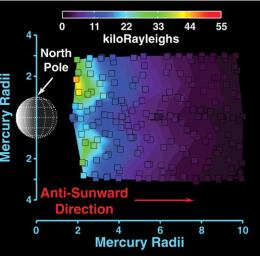
|
Exploring Mercury’s “Tail”
- Click the image above for a larger view
- Full-Res JPEG (515 x 507) (37.6 kB)
- Full-Res TIFF (515 x 507) (784.4 kB)
Caption:
As the MESSENGER spacecraft approached Mercury, the UVVS field of view was scanned across the planet's exospheric "tail," which is produced by the solar wind pushing Mercury's exosphere (the planet's extremely thin atmosphere) outward. This figure, recently published in Science magazine, shows a map of the distribution of sodium atoms as they stream away from the planet (see PIA10396 ); red and yellow colors represent a higher abundance of sodium than darker shades of blue and purple, as shown in the colored scale bar, which gives the brightness intensity in units of kiloRayleighs. The escaping atoms eventually form a comet-like tail that extends in the direction opposite that of the Sun for many planetary radii. The small squares outlined in black correspond to individual measurements that were used to create the full map. These measurements are the highest-spatial-resolution observations ever made of Mercury's tail. In less than six weeks, on October 6, 2008, similar measurements will be made during MESSENGER's second flyby of Mercury. Comparing the measurements from the two flybys will provide an unprecedented look at how Mercury's dynamic exosphere and tail vary with time.
Date Acquired
: January 14, 2008
Instrument
: Ultraviolet and Visible Spectrometer (UVVS) of the Mercury Atmospheric and Surface Composition Spectrometer (MASCS)
Background Info:
These images are from MESSENGER, a NASA Discovery mission to conduct the first orbital study of the innermost planet, Mercury. For information regarding the use of images, see the MESSENGER image use policy .
Cataloging Keywords:
| Name | Value | Additional Values |
|---|---|---|
| Target | Mercury | |
| System | ||
| Target Type | Planet | |
| Mission | MESSENGER | |
| Instrument Host | MESSENGER | |
| Host Type | Orbiter | |
| Instrument | Mercury Atmospheric and Surface Composition Spectrometer (MASCS) | |
| Detector | ||
| Extra Keywords | Atmosphere, Color, Comet, Map, Ultraviolet | |
| Acquisition Date | ||
| Release Date | 2008-08-26 | |
| Date in Caption | 2008-01-14 | 2008-10-06 |
| Image Credit | NASA/Johns Hopkins University Applied Physics Laboratory/Arizona State University/Carnegie Institution of Washington. Figure 1 from McClintock et al., Science, 321, 92-94, 2008. | |
| Source | photojournal.jpl.nasa.gov/catalog/PIA11076 | |
| Identifier | PIA11076 | |
